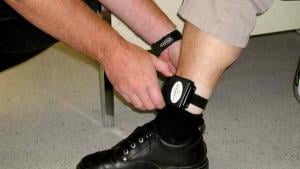A group of 30 men walk into the intake facility at Cook County Jail. They have all been accused of a crime. If they can post bail, they'll be out by the end of the day. If not, they could be confined to the already overcrowded jail facility.
County Board President Toni Preckwinkle is concerned about overcrowding and the cost of housing all these defendants. She said she'd like to reduce the daily inmate population by about a thousand.
“There are a half billion dollars spent on jail...you can do a lot with that money,” said Preckwinkle. “It doesn't seem to me to be the most productive use of tax resources keeping people in jail if you have reasonable expectation that they'll be back in trial.”
Juan - who prefers we don't use his last name – walks to the processing desk, signs his name, and gets his mugshot. He has been booked for driving on a revoked license. He was unable to post the bail set for him by a bond judge.
 Instead of being given a jail cell, Juan is being fitted for an electronic ankle monitor.
Instead of being given a jail cell, Juan is being fitted for an electronic ankle monitor.
"You can verify you have a job?" asked a corrections officer.
He'll be allowed to go to work and instead of sitting in jail to await trial, which could take days, weeks, or even months, Juan is going home.
“He's a non-violent offender, individual that's going back into the community, to his home life, to provide for his family,” said Gregory Shields, Director of the County’s Electronic Monitoring program. "Certainly, he doesn't need to be in the Department of Corrections.”
Inmates deemed eligible for home confinement by a bond judge will get the bracelet and be watched 24/7 through a radio frequency emitted by the bracelet.
“They're monitored every move they make. If they have to go to church, schools, they need to go, they're given permission and we have individuals that go follow up on that, “ said Shields. “It’s not 100 percent fail-safe. It’s not a ball and chain, it’s an honor system.”
Juan is followed home by corrections officers. Shields said that Juan is probably not a threat to anybody, and that a so-called non-violent defendant like him stands to lose a lot by staying in jail.
“He could stay in jail, his family could figure out how they're going to get his bond, 4-5 days later, he's out of work,” said Shields. “We're trying to stop these individuals from coming back into jail consistently and place them back into their house to let them know, 'hey, you have another chance at this.'”
After setting up monitoring equipment, Juan's cuffs can come off.
Upon arriving at jail, Juan said he was scared at the prospect of staying in jail for an extended period. He said he has a wife and kids to provide for. Now, he’ll be home with them.
There's also a financial incentive for the county to expand the program. Shields said it costs $143 a day to keep an inmate locked up. If the inmate is home on surveillance, the cost goes down to $65.
 In 2009, there were around 300 alleged offenders on electronic monitoring at home. This year, to this point, there have been 1,100, and that includes some who have been accused of violent crimes.
In 2009, there were around 300 alleged offenders on electronic monitoring at home. This year, to this point, there have been 1,100, and that includes some who have been accused of violent crimes.
“The judges have their own ability to place any defendant on electronic monitoring,” said Shields.
Illinois law says a judge cannot let out anyone accused of some violent crimes, like murder or criminal sexual assault, out on monitoring without first posting bail. Victims' rights spokesperson Jennifer Bishop-Jenkins says certain defendants, though innocent until proven guilty, should not be back in the community.
“If it's a non-violent offender, we're fine with that,” said Bishop-Jenkins. “But if it's a violent offender, no, absolutely not.”
“If they get out on bond, what's wrong with putting them out on electronic monitoring?” asked Preckwinkle. “People who are out on bond can commit crimes. The alternative is that everyone should be locked up awaiting trial. You are presumed innocent until guilty.”
Preckwinkle insists the overwhelming majority of those on electronic monitoring are accused of non-violent crimes. Shields said that only 3 percent have either escaped the bracelet, or committed another crime while being monitored - a deviation so small that he says the financial and social benefits of the program far outweigh the risks.
Those charged with drug offenses make up the largest portion of electronic monitoring participants. The Cook County Board President's office this year announced $1 million in funds for the program that would go toward job training and other programs for alleged offenders. Attempting to escape the electronic monitor carries a sentence of three to seven years.
What do you think? Do you believe some alleged violent offenders should be let out on electronic monitoring? Post your comments below or sound off on our discussion board!



